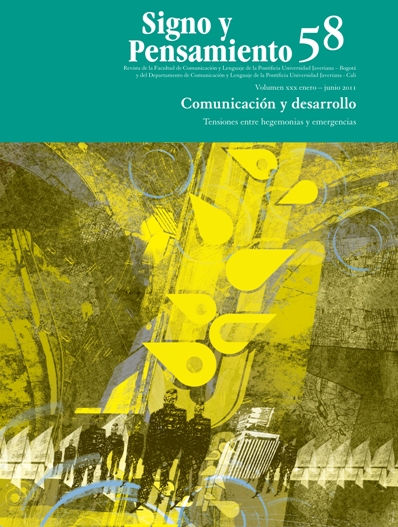Resumen
El artículo refiere la construcción sociocultural que se realiza del cluster textil/confección, diseño y moda de Antioquia, desde la metáfora “el cluster es guerra”. Se presenta el cluster como forma emergente de organización de la producción, así como la metodología llevada a cabo en el proceso de interpretación de las expresiones metafóricas. Se interpretan las metáforas desde las que se dibuja dicho cluster: “el mercado es guerra”, “el combate por el mercado es miedo”, “el combate es aquí y allá”, “la competencia es grande, aliada e importante”, y desde las estrategias y tácticas utilizadas por los constructores del cluster, tanto para la lucha como para la defensa del mercado. El texto es un aparte de los resultados de la investigación doctoral que realizó la autora sobre dicho cluster.
Bauman, Z. (2006), Miedo líquido: la sociedad contemporánea y sus temores, Buenos Aires, Paidós Ibérica.
Benavides C., J. (1997), “Comunicación, cultura y política. Desarrollo y globalización ¿un horizonte sin ilusiones?”, en ix Encuentro Latinoamericano de Facultades de Comunicación Social (Felafacs), Lima, Universidad de Lima.
Black, M. (1954), Metáfora, procedimientos de la sociedad aristotélica. La filosofía del retórico, Oxford, Prensa de la Universidad de Oxford.
Bustos, E. (2000), La metáfora, ensayos transdisciplinares, Madrid, Universidad Nacional de Educación a Distancia, Fondo de Cultura Económica.
Cámara de Comercio (2005), Balance tecnológico, cadena productiva, Bogotá, Cámara de Comercio de Bogotá.
Castells, M. (2004), The Power of Identity, Malden, MA, Blackwell.
— (2004), “La era de la información”, La sociedad red, vol. 1, Madrid, Alianza Editorial.
Fuentes, N. R. (2010), Doctorado en Estudios Científicos Sociales, Guadalajara, iteso, Universidad Jesuita de Guadalajara.
Hesse, M. (1966), Models and Analogies in Science, Notre Dame, University of Notre Dame Press.
Isus, S.; Cela, J., y Farrús, N. (2002), “Desarrollo de competencias de acción profesional a través de las tecnologías de la información y la comunicación: una visión crítica”, en Actas del ii Congreso Europeo en Tecnologías de la Información y la Comunicación y la Ciudadanía, Barcelona, Universidad de Barcelona.
Lakoff, G. y Johnson, M. (1998), Metáforas de la vida cotidiana, Madrid, Cátedra.
Lizcano, E. (1998), “La metáfora como analizador social”, Revista Empiria, núm. 2, pp. 29-60.
Martín-Barbero, J. (1995), “Pretextos”, Conversaciones sobre la comunicación y sus contextos, Cali, Colección Ensayo Iberoamericano, Universidad del Valle.
Porter, M. (1998, noviembre-diciembre), “Clusters and the new economics of competition”, Harvard Business Review, vol. 6, núm. 76, pp. 77-90.
Real Academia Española (rae) (2007), Diccionario, Real Academia Española (rae) [en línea], disponible en http://buscon.rae.es/diccionario/ drae.htm, recuperado: 10 de julio de 2007.
Reguillo, R. (2006), “Los miedos: sus laberintos, sus monstruos, sus conjuros. Una lectura antropológica”, Etnografías contemporáneas, vol. 2, núm. 2, pp. 45-74.
Rivano, E. (1997), Metáfora y lingüística cognitiva, Santiago de Chile, Bravo y Allende Editores.
Valle Flórez, M. (2009, julio-diciembre), “Categorías de análisis de los estudios sobre cluster en las corrientes de la economía industrial y de la aglomeración”, Revista Politécnica, núm. 9, pp. 72-86.
Witker, I. (2006), China/América Latina: la relación con una potencia anti status quo. Academia Nacional de Estudios Políticos y Estratégicos de Chile [en línea], disponible en http://www. anepe.cl3 oro/Articulos/columna Witker04. htm, recuperado: 4 de julio de 2007.
Esta revista científica se encuentra registrada bajo la licencia Creative Commons Reconocimiento 4.0 Internacional. Por lo tanto, esta obra se puede reproducir, distribuir y comunicar públicamente en formato digital, siempre que se reconozca el nombre de los autores y a la Pontificia Universidad Javeriana. Se permite citar, adaptar, transformar, autoarchivar, republicar y crear a partir del material, para cualquier finalidad (incluso comercial), siempre que se reconozca adecuadamente la autoría, se proporcione un enlace a la obra original y se indique si se han realizado cambios. La Pontificia Universidad Javeriana no retiene los derechos sobre las obras publicadas y los contenidos son responsabilidad exclusiva de los autores, quienes conservan sus derechos morales, intelectuales, de privacidad y publicidad.
El aval sobre la intervención de la obra (revisión, corrección de estilo, traducción, diagramación) y su posterior divulgación se otorga mediante una licencia de uso y no a través de una cesión de derechos, lo que representa que la revista y la Pontificia Universidad Javeriana se eximen de cualquier responsabilidad que se pueda derivar de una mala práctica ética por parte de los autores. En consecuencia de la protección brindada por la licencia de uso, la revista no se encuentra en la obligación de publicar retractaciones o modificar la información ya publicada, a no ser que la errata surja del proceso de gestión editorial. La publicación de contenidos en esta revista no representa regalías para los contribuyentes.


